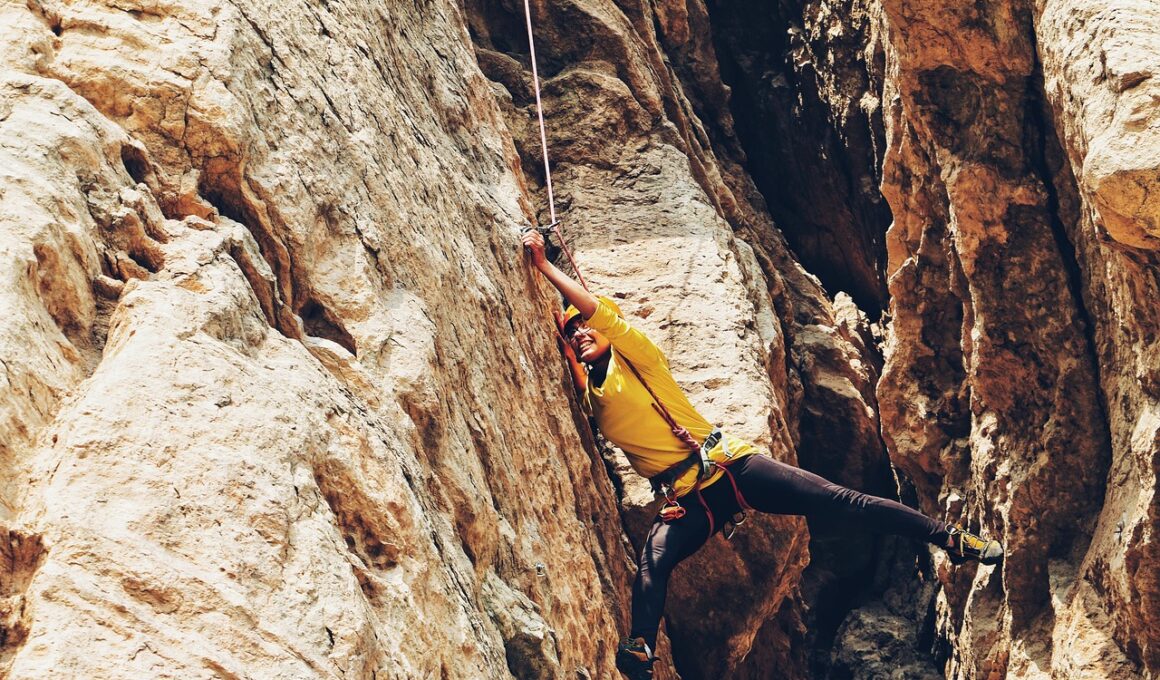Environmental Impact: How to Rappel Responsibly
Rappelling is an exhilarating outdoor activity that thrills adventure seekers, but it comes with significant environmental responsibilities. As an adventurer, it is crucial to understand the potential impacts that rappelling can have on natural landscapes and ecosystems. Choosing the right locations for your rappelling adventures is essential. Avoid areas that are ecologically sensitive or heavily trafficked, as these environments are often fragile. Instead, opt for secluded spots where your presence and activities won’t disturb wildlife or vegetation. Moreover, always adhere to local guidelines and regulations regarding rappelling. This includes accessing appropriate permits when required, as well as respecting any restrictions in place. By doing so, you can contribute to the conservation of these natural sites and ensure they remain intact for future adventurers. Essential gear also plays a role in responsible rappelling practices. Always use durable and environmentally friendly equipment. Consider choosing biodegradable ropes and harnesses to minimize your impact on the surroundings. Not only does this reflect a commitment to the environment, but it also promotes a culture of responsibility within the outdoor community.
Leave No Trace Principles
To rappel responsibly, it’s essential to adopt the Leave No Trace principles, which are designed to minimize human impact on natural environments. The first principle is to plan ahead and prepare accordingly. This involves researching the area where you intend to rappel and understanding the environment. Make sure you know the best practices for minimizing damage to the site. When rappelling, strive to stick to established trails and routes, as this helps prevent erosion and habitat destruction. When setting up your rappel station, choose locations away from fragile plants or trees, as their roots can be shallow and sensitive. Additionally, it is vital to pack out everything you bring in. This includes wrappers, leftover food, and any gear that might break during your adventure. Improper disposal of litter and trash can harm local wildlife and decompose poorly in natural environments. Simply put, carrying out what you bring in is a foundational aspect of environmental stewardship. Ensure that you also educate fellow adventurers about these principles. By sharing knowledge on how to respect nature, everyone can enjoy their outdoor experiences while helping to preserve the environment.
Rappelling adventures can create lasting memories, but these experiences should not come at the expense of natural habitats. It’s important to understand the wildlife that coexist in the areas you explore. Many animals, such as birds and small mammals, rely on these ecosystems for food, shelter, and breeding. Careless rappelling, including disturbing nests or disrupting habitats, can lead to negative consequences for these creatures. Make it a point to observe wildlife responsibly. Maintain a respectful distance to avoid stressing animals. In addition to wildlife awareness, consider the impact you have on local vegetation. Rappelling can accidentally lead to trampling of plants, which not only harms their ecosystem but also the aesthetic beauty of the area. Engage in minimal impact practices when rappelling, such as carefully selecting where to set up ropes or resting. Using established trees or boulders while ensuring a small footprint creates less disruption. Be conscious of your actions and the effects they have on the ecosystem. Building these habits fosters an appreciation for nature and encourages others in your group to emulate responsible behaviors.
Importance of Community Awareness
It’s critical to promote community awareness about environmental impacts associated with outdoor activities, such as rappelling. Engaging with fellow adventurers and local organizations can make a significant difference. Consider attending workshops or participating in local clean-up events, which often provide valuable education on minimizing environmental footprints. Through these gatherings, individuals can exchange insights, experiences, and suggestions for being responsible. Organizing or participating in community outreach programs is another excellent approach. Activities such as trail maintenance or educational seminars empower individuals with knowledge on sustainable outdoor practices. By fostering collaboration, you can inspire others to take action in their environments. Online forums and social media platforms can also serve as a means to share your experiences and tips. An effective way to create awareness is to document your own responsible practices on social media. Share photos of your adventures while highlighting your commitment to sustainability. This can spread positive messages and encourage others to follow suit. Giving back to the community not only enhances your connections with nature but also reinforces a culture of environmental consciousness.
Promoting responsible rappelling also involves understanding and participating in conservation efforts. Many outdoor regions are facing threats from both natural and human-induced challenges, such as climate change and tourism. By supporting local conservation groups, you contribute to the preservation of natural sites used for rappelling. Research and identify organizations actively engaged in protecting these areas and related ecosystems. Volunteering your time or financially supporting such organizations can lead to more sustainable outdoor experiences. Additionally, educating yourself about the flora and fauna in these areas is essential. Understanding local biodiversity can enhance your rappelling adventures by providing context and appreciation for the environment. Knowledge equips you to act responsibly and make conscious decisions while enjoying the outdoors. Encourage your acquaintances to reflect on the environmental impacts of their own adventures and to join conservation efforts collectively. By working together, people inspire positive change and promote responsible recreation. Engaging in these initiatives ensures that outdoor sports like rappelling can continue for generations while being mindful of the natural world.
Choosing Eco-Friendly Gear
One of the most effective tactics for responsible rappelling is to select eco-friendly gear. Modern advancements have led to the development of environmentally sustainable outdoor equipment. Ropes made from recycled materials and harnesses designed with biodegradable components help reduce plastic waste. By investing in high-quality gear with a minimal environmental impact, you help promote sustainable practices in the adventure sports community. Moreover, consider the durability of your equipment. High-quality gear lasts longer, reducing the likelihood of disposal and waste accumulation in the environment. Research different brands and their commitment to sustainability. Look for companies adhering to ethical manufacturing practices and utilizing eco-friendly materials. When repurchasing gear, investigate options such as second-hand equipment or rental services. By doing so, you’ll lower your carbon footprint, minimizing unnecessary production demands. Moreover, always remember the significance of gear maintenance. Proper care ensures a longer lifespan, promoting responsible consumption patterns. Not only does this approach benefit the environment, but it also fosters a sense of community among adventure enthusiasts united by sustainable choices. By opting for eco-friendly gear, you send a powerful message about the importance of taking care of our planet.
Finally, consider the importance of interaction with fellow rappellers. Open conversations regarding environmental responsibility can inspire positive changes. Discuss techniques for minimizing environmental impacts during rides, sharing personal insights and experiences along the way. Strong connections form when people exchange ideas and practices for ecologically mindful activities. Host gatherings or group excursions centered around sustainable rappelling practices, allowing individuals to learn collectively. Organizing themed events or mentorship opportunities focuses on responsible rappelling while fostering shared enthusiasm for adventure sports. Join local clubs or organizations that prioritize conservation while enjoying outdoor activities. Networking within the community offers a unique chance to learn new skills and acquire knowledge about minimizing ecological disruption. When attending events, be sure to take part in any discussions about environmental impact and responsible practices. Ultimately, the culture of responsible rappelling relies on collective efforts, camaraderie, and shared values. Together, rappellers can unite to promote a sustainable outdoor experience. Advocacy within the community sparks awareness and drives individuals toward adopting environmentally responsible practices that benefit our planet.
By practicing responsible rappelling, we can protect the beauty of our natural world while enjoying thrilling outdoor adventures. It is a shared obligation to preserve these environments for future generations. Adopting sustainable practices is easier than it seems. By educating ourselves, advocating for conservation, and sharing our experiences, we can create lasting change. Responsible rappelling does not prevent enjoyment of the sport; rather, it enhances it, allowing for deepened relationships with nature and shared experiences among adventurers. As a community, we can inspire others to think about their environmental choices. Engage conversations with others about the positive impacts of practicing responsible outdoor sports. Change occurs when individuals unite around the common goal of protecting nature. So let’s cherish our beautiful designs, share these experiences with others, and contribute to a healthier planet. Responsible rappelling is more than just an adventure; it is a commitment to stewardship and sustainability. The future of our favorite locations depends on our efforts today. Let every rappel, every adventure be a reminder of our duty to our planet. Together, we can create harmony between thrill-seeking and ecologically responsible practices.


